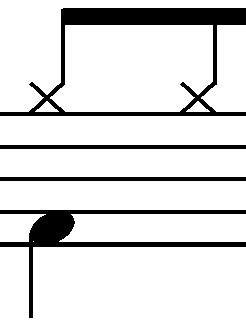An explanation of what a groove is, how they are used and a list of beginner lessons on playing them.
 Drumscore
Drum Sheet Music, Playing Guides, Lessons and Transcription Services
Drumscore
Drum Sheet Music, Playing Guides, Lessons and Transcription Services

The basics of playing drum beats, one of the absolute essentials for play songs on the drums. Through this page you will learn what a groove is, how they are used, how to read them and ideas for creating variations on these introductory ideas. Lessons are listed in the order I recomend working through them.
Rhythm First Reading Method
A beginners lesson on reading and constructing grooves by finding a base rhythm.
Left To Right Groove Reading Method
An alternative method of reading grooves, this time starting at the left of the bar and working through one stroke at a time.
Basic Groove Example 1
A simple groove made of quarer and eighth notes presented using the rhythm first method.
Basic Groove Example 2
A simple groove made of quarer and eighth notes presented using the rhythm first method.
Basic Groove Example 3
A simple groove made of quarer and eighth notes presented using the rhythm first method.
Basic Groove Example 4
A simple groove made of quarer and eighth notes presented using the rhythm first method.
Basic Groove Example 5
A simple groove made of quarer and eighth notes presented using the rhythm first method.
Basic Groove Example 6
A simple groove made of quarer and eighth notes presented using the rhythm first method.
Basic Groove Example 7
A simple groove made of quarer and eighth notes presented using the rhythm first method.
Basic Groove Example 8
A simple groove made of quarer and eighth notes presented using the rhythm first method.
Basic Groove Example 9
A simple groove made of quarter notes and rests presented using the rhythm first method.
Using The Ride Cymbal In A Groove
Vary your grooves by switching the right hand to another very commonly used cymbal, the ride.
Using Alternate Hi Hat Sounds In Grooves
Use the left foot to control wether the hi hat is open or closed in a groove.
Using The Crash Cymbal For The Right Hand In A Groove
Continue developing your grooves by learning about using a crash ride cymbal instead of the hi hats.
Using The Floor Tom As The Basis For A Groove
Learn some new variations on existing grooves that make use of toms.
Level 0 Grooves With Kicks On '+' Counts
Constructing simple grooves with common time snares and kicks only on '+' counts.
Adding An Eighth Note Kick At The End Of A Level 0 Groove
A simple variation on the original level 0 basic grooves that involves adding one more bass drum at the end of the bar.
Adding An Eighth Note Snare At The End Of A Level 0 Groove
A simple variation on the original level 0 basic grooves that involves adding one more snare drum at the end of the bar.
'Please Please Me' Groove
A simple variation of a previous level 0 groove shown in a practical context.
Lessons
- Theory
- Articles
- Rudiments
- Single Stroke
- Double Stroke
- Paradiddle
- Triplet
- Flams And Drags
- Level 0
- Level 1
- Level 2
- Level 3
- Tracks
HOT: Most Popular Recently
- Wagon Wheel by Darius Rucker
- Take Me Home. Country Roads by John Denver
- Wildest Dreams by Taylor Swift
- Hollywood Nights by Bob Seger
- It's Raining Men by The Weather Girls
- Under Pressure by Queen
- A Kind Of Magic by Queen
- When It Rains It Pours by Luke Combs
- Hosanna by Hillsong United
- Don't Look Back In Anger by Oasis




















